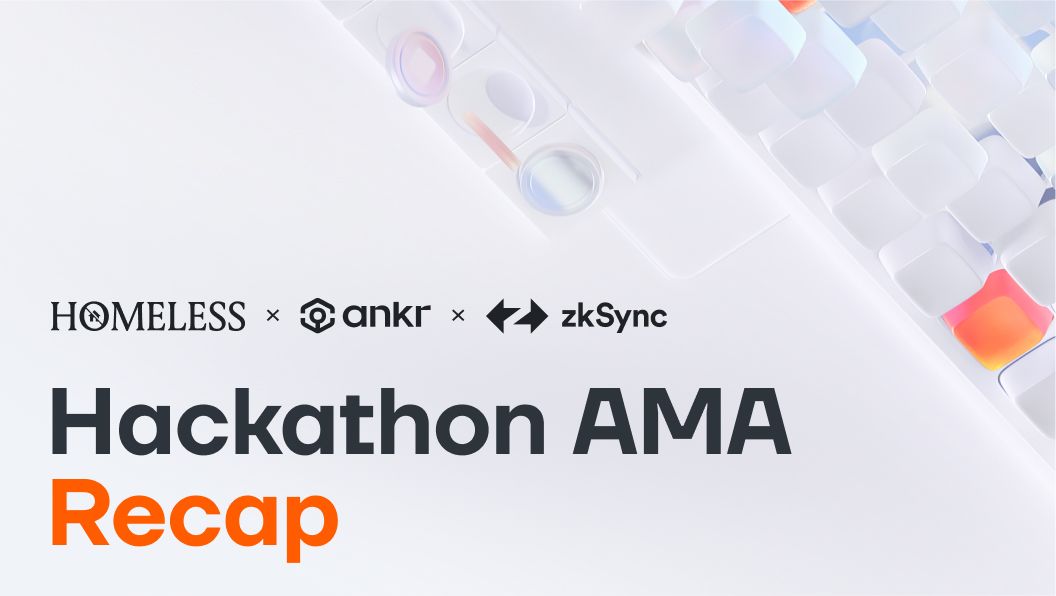Hackathon Highlights From the AMA & What’s Coming Jan. 22!

Kevin Dwyer
December 20, 2023
12 min read

In case you missed it, last week, Ankr, zkSync, and Homeless Ventures went live on X for an Ask Me Anything session that had the platform buzzing. From Layer 3 to Web3 UX to DeFi developments, the speakers dropped knowledge bombs that would give any builder FOMO. But don’t worry! This article dives into the juiciest highlights surrounding the upcoming hackathon for your reading pleasure.
Register for the January 22 Hackathon Now!
Intros of the Team
Nathan from Ankr
I’m a BD representative at Ankr, and I’m excited to tap into this hackathon that we're doing with homeless ventures and ZK sync and tell you guys a little bit about it. As far as the vision from Ankr, basically, we're looking to really empower developers to use our infrastructure to go and build on new chains like ZK sync.
Omar from zkSync
Hey, guys, it's Omar, head of BD for ZK sync. Yeah, super excited to see what people build. Really thankful for Ankr having me here. You guys have been fantastic partners for the zkSync ecosystem since day one.
Mai from Homeless Ventures
I come from a traditional finance background. I'm also a protocol founder, and I do a lot of work with Homeless Ventures. We're an early-stage decentralized investment group that focuses on the latest and greatest – the bleeding-edge DeFi innovations in the space.
What Inspired This Joint Hackathon?
Nathan: The whole inspiration for the hackathon came from our realization that we have all these developers entering the blockchain space and getting their RPCs as the first step to building new projects, and we really want to empower this developer community and narrow their focus into some of our partners. So I thought it'd be really dynamic to go with some new ZK technology with zkSync.
Mai: We wanted zkSync and Ankr as partners because zkSync makes it really easy to deploy new L2s, L3s, and Ankr has really incredible RPC infra that is super helpful for everything that the broad DeFi landscape needs. So, on one hand, you have a group that's putting a lot of powerful tools in the kits of various developers for new chains and such. And then on the other, the backbone of the new Internet with the RPC calls for every blockchain under the sun.
What’s the Big Deal With Layer 3 and Hyperchains from zkSync?
Mai: Omar, I was wondering if you can explain your thesis or what you think about layer threes launching app chains (aka hyperchains) with zkSync, because I think we could get some app chains built out of this hackathon. For instance, if a developer wants to build an AMM, I'm sure zkSync is scalable enough, but I think having these specific app chains (hyperchains) is not a bad bet if you want to have a long-lasting dApp.
Omar: Of course, So we obviously have zkSync Era, which is our mainnet. And that is essentially what we call the first hyperchain. So it's a ZK rollup, layer two on Ethereum. It's been live for about nine months.
zkSync Era is based on our latest prover upgrade called Boojum. It's now essentially the cheapest layer 2 rollup out there. At the same time, it's also doing the most transaction volume. And so that implies a few things – the tech is good, it scales, and you're not seeing these price fluctuations anymore. So using that same technology, we are essentially allowing anyone to go ahead and build their own layer two. We call these hyperchains. So you could go to zkstack.io, and deploy your own ZK rollup right now as we speak.
If you want to create a different DA layer, for example, using Celestia, you'll be able to do that. If you wanted to use EigenDA, you could do that too. So you'll be able to take advantage of what a lot of these modular ecosystems are bringing to the table. On top of that, we also have Rollup as a Service providers like Ankr that will allow you to customize every piece of the new chain and deploy all of your own infrastructure.
Benefits of Building With the ZK Stack
Omar: zkSync is very interesting for a lot of developers because now they've got this optionality to either build directly on our mainnet or deploy a new hyperchain only serving their application.
- Scalability: You can go ahead and build a very small-scale app-specific hyperchain that can even run on your desktop because the actual underlying tech, the prover, only requires 16 gig GPU. And that's very unique to ZK Stack. What that means is you can essentially run on your own layer two with working proofs on your MacBook or desktop. If you really want to run a very small personal application, if you want to run a very large web scale application, you can also do that as well. But this thing scales to as much as what our mainnet scales to. There's really no limit there.
- Interoperability: The other benefit of actually joining ZK Stack and building your own hyperchain is that it comes with a native messaging protocol. And so every single hyperchain will be able to connect directly with any other hyperchain. And so you'll essentially have a trustless ZK bridge from one L2 to another L2 that will be extremely fast and cheap.
- Affordability & Modularity: What's really setting ZK Stack apart is that we've got the proven tech that can scale. You can just check our zkSync Era stats right now. It's going to be incredibly cheap. Additionally, you can make it modular. So if you want Celestia, you can add that in. And then, if you want someone to actually manage the whole infrastructure for you, well, you've got Ankr to do that for you as well. On top of that, you don't have to worry about fragmentation. Like you roll this thing up, you will have a native bridging to zkSync Era or to any other layer two that uses ZK Stack.
What dApps Could Be Built On zkSync for the Hackathon?
Nathan: I'm just wondering what kind of dApps you guys really want to see here being built on zkSync?
Mai: I think the main value proposition of a lot of the hyperchain tech is high throughput. So obviously you can have the AMMs and the lending markets and the more conventional technical solutions. But I feel like there are a lot of things that people really like conceptually that are a bit more difficult to do. Something like doing an implementation on Ethereum mainnet where a single action might cost 10, 15, or 20 USD. That's things like gamifying, like on-chain games, or rendering stuff on chain or order book operations – a lot of those kind of more high throughput use cases that are just generally ‘churning the blocks,’ if you will. That's really what gets unlocked by this new technology. I think if we could see some stuff like that, that'd be pretty exciting.
Omar: We're finally enabling Web2-like scaling with incredible capacity. I think this will lead the shift to an abundance mindset of doing something like a 10 million mint, right? Would you do that on mainnet and risk having it potentially get clogged by someone else doing a big event? Well, what if you just booted up a layer two real quick, and did your 10 million mint there? And then just bridge them over to mainnet and then just shut it down. So you can start thinking of these as ephemeral servers that just go on and off as you need capacity.
Also, say you build a large layer two for a metaverse or game. So you build a layer two base chain. That is your game. But then let's say you have a big event and you need to mint a lot and it's going to be a significant amount of capacity. Well, all right, just boot up another layer two or boot up another layer three. Have your mint there, bridge it all over and shut it down very quickly. That is a very interesting design space that I would really like to see people experiment with. Just the same way we use Docker and containers.
What Support Can Devs Expect for the Hackathon?
Nathan: For developer support on the hackathon, I'm stoked to announce that Ankr is going to be sponsoring infrastructure for developers. So we will basically be giving out API keys. When you sign up, we'll get your email in our database and give you basically unlimited credits to build central limit order books or really high throughput apps. Anyone building on ZK sync should definitely be participating in this.
Mai: I believe that for the winning project, Homeless Ventures is committed to investing in any form of capital raise. Whether that be a seed round, pre-seed, or other capital raise. Ankr also will be giving out some prizes to the winners, so it will be a competitive one!
What Are the Top Industries You Want To See Solutions Built For?
Omar: There's a lot. I'd like to see AI being leveraged a little bit more by blockchain. I feel like there's that security aspect, of course. Like ChatGPT, who knows where my data is when I put in all these crazy questions? It's kind of concerning to see that's one side, the infrastructure. So moving the back end of data from Web2 infrastructure to Web3 in a more distributed open network, I think would be cool. And having DAOs really be able to decide these algorithms. Say, if we are using decentralized Twitter, I could pick an algorithm that suits what I want to see, not what some large stakeholders might be making us see. So definitely, the social media side of things is where I'm pretty interested. And I think AI also can come in on the frontend, not necessarily having to tweak out the backend a ton with smart contracts, but the way it's like reading and listening and maybe helping people snipe some new meme coins or cool stuff like that.
What Companies Are the Most Exciting In Web3? What Makes a Successful Startup?
Omar: I'd say the most exciting companies to me in Web3 yeah, it's actually companies that are kind of taking more of a risky approach to just building something completely new. I'd say for me, Jupiter, that user experience on Solana has been great for trading. It's got the high throughput, and low fees. Anything that's trying to improve user experience right now across the board, I support it. And of course, all this infrastructure that all these infra providers are doing, it's so essential to keep the low latency and the performance and yeah. Favorite companies in Web3 it's got to be layer one, layer two, blockchain companies like just really trying to push for people to use their block space and be creative by solving the UX and crypto. I think it's safe to say that when the EVM came out and the Turing complete blockchain to transfer value across and build these insane applications like AMMs, those led to some breakthroughs. But now the companies that are focusing on like ZK sync, focusing on more scalable solutions and better user experience, I think we're still so early in the infrastructure phase and that's mainly where my interest is as like a Defi end user. I want to see more EVM-central limit order books. That'd be really cool. I think the attributes that make a successful startup in Web3 are people that are looking to solve a root problem that hasn't been solved yet. It seems like a lot of people in this industry are working on the same thing simultaneously. It's hard to go and break free from the bubble and build something new, but I want to see more of that. Take a swing at a crazy problem that could even be building just like a DAO that connects a lot of things in the real world. I think an Airbnb-type of DAO would also be cool.
Mai: I think there's a ton of opportunity to build, as you said, like real-world asset stuff on chain, building novel, like game solutions that are validated on chain. I think the ability to reduce the necessity of individuals, like underwriting things or managing things themselves and having the code do that is really powerful. So we should be moving more stuff on chain, not less. And I think a lot of that needs to be championed by applications themselves. And whatever those applications are, there needs to be a wide breadth of them. And that can be everything from these DeFi solutions to gamefy solutions to everything in between. Yeah, 100%. Also, I just think at the end of the day, it's like we need to have more choices given in Web2 there's a few giant conglomerates that are just taking over all the mind share, market share. They got these big takeaway rates. I think in Web3 those takeaway rates can be much smaller. Users own their data. We get to actually have ownership and vote on where protocols go and stuff.
How Can We Improve the User Experience of Web3?
Omar: I'm interested in seeing someone come up with some new idea for tackling a problem that is very persistent in this industry. And one problem that is a huge issue is the on and off ramping. Right. You either need to go through a central exchange and use them as like a pass-through to on-ramp, which has significant fees, or you have a direct on-ramp which also then has an 8% cut rate. A company that just started is ZK P2P. What they've done is very novel. They've essentially said, okay, what if you use your Venmo account to just directly on-ramp into crypto? The rates are so much lower and it also goes through KYC. And that sparks a whole new avenue of, hey, what if you just use an existing KYC app, like a cash app or maybe like Alipay, etc, and use that to directly on-ramp onto crypto? Because I think one of the biggest issues we have in this industry is how do you actually get people on board? How do you actually get people into Web3 that doesn't require 1020 different steps? And I think this is a very interesting new design space that they just opened up. And I'm pretty excited to see where this goes.
What Criteria Are the Judges Looking for During the Hackathon?
Nathan: As far as the criteria, that's something that's still pretty open, I'd say. I'd say focusing on user experience, solving problems around that is something I really want to see. So that making sure you've tested out your app quite a bit like rigorous testing, the whole UX. We're going to have a sheet of this criteria, but just around an open discussion right now. I think what I've heard a lot of from both of you guys is a focus on kind of breaking down barriers or just complexity of interacting with DeFi or even the solutions themselves. So I think that you touched on it briefly there, but like the UI/UX aspect, making it more Web2 makes it that much easier to engage with. I think that's a pretty important thing to hit on because there hasn't really been that much focus placed on that for current DeFi solutions. So it's like, as much as people are like, oh, let's make Web3 It's better than Web2 I think there's still some lessons there in Web2 with let's make the user experience really clean and available for a broad audience because that's how you're going to onboard the next billion users.
Learn more about the hackathon.
Join the Conversation on Ankr’s Channels!
Twitter | Telegram Announcements | Telegram English Chat | Help Desk | Discord | YouTube | LinkedIn | Instagram | Ankr Staking



